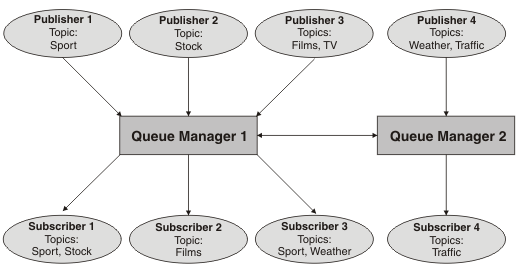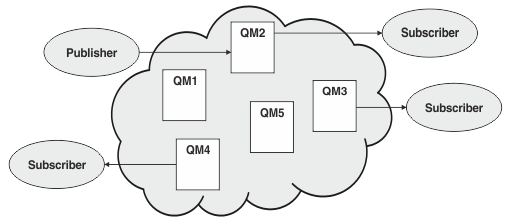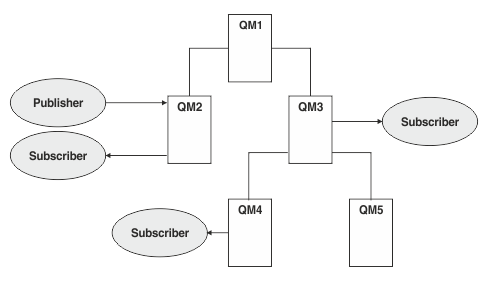Distributed publish/subscribe networks
Each queue manager matches messages published to a topic with the locally created subscriptions that have subscribed to that topic. You can configure a network of queue managers so that messages published by an application connected to one queue manager are delivered to matching subscriptions created on other queue managers in the network. This requires additional configuration over simple channels between queue managers.
- Queue manager 2 is used by Publisher 4 to publish weather forecast information, using a topic of Weather, and information about traffic conditions on major roads, using a topic of Traffic.
- Subscriber 4 also uses this queue manager, and subscribes to information about traffic conditions using topic Traffic.
- Subscriber 3 also subscribes to information about weather conditions, even though it uses a different queue manager from the publisher. This is possible because the queue managers are linked to each other.

You can manually connect queue managers in a parent and child hierarchy, or you can create a publish/subscribe cluster and let IBM® MQ define much of the connection detail for you. You can also use both topologies in combination, for example by joining several clusters together in a hierarchy.
Overview of publish/subscribe clusters
A publish/subscribe cluster is a standard cluster with one or more topic objects added to the cluster. When you define an administrative topic object on any queue manager in a cluster, and make that topic object clustered by specifying a cluster name, then publishers and subscribers to the topic can connect to any of the queue managers in the cluster, and messages published are routed to the subscribers over cluster channels between queue managers.

- direct routing
- topic host routing
When you configure a direct routed clustered topic, messages published on one queue manager are sent directly from that queue manager to every subscription on any other queue manager in the cluster. This can provide the most direct path for publications but does result in all queue managers in a cluster becoming aware of all other queue managers, each potentially having cluster channels established between them.
When you use topic host routing, messages published on one queue manager are sent from there to a queue manager that hosts a definition of the administered topic object. That topic host queue manager routes the message on to every subscription on any other queue manager in the cluster. If the publishers or subscribers are not located on the topic host queue managers, this results in a longer route for publications. However, the benefit is that only the topic host queue managers become aware of all other queue managers in the cluster, and potentially have cluster channels established with them.
For more information, see Publish/subscribe clusters.
Overview of publish/subscribe hierarchies
A publish/subscribe hierarchy is a set of queue managers connected by channels into a hierarchical structure. Each queue manager identifies its parent queue manager, as described in Connecting a queue manager to a publish/subscribe hierarchy.
Publishers and subscribers to a topic can connect to any queue manager in the hierarchy, and messages flow between them using the hierarchical queue manager connectivity.

In the previous figure, publications delivered to the subscribers on QM3 and QM4 have been routed from QM2 to QM1 and then onto QM3 and finally QM4.
Hierarchies give you direct control over the relationships between every queue manager in the hierarchy. This allows fine-grained control over the routing of messages from publishers to subscribers, and is especially useful when routing between queue manager networks with restricted connectivity. You should give careful consideration to the availability and capability of every queue manager through which a message is routed on its way from publisher to subscribers.
For more information, see Publish/subscribe hierarchies.
Publication distribution between queue managers
- Only send publications from one queue manager to the queue managers that currently host a subscription for that publication.
- Send each publication to all queue managers, and let them match it against their subscriptions.
By default, IBM MQ uses the former method, in which publications are only sent to queue managers that have subscriptions for them. The subscription knowledge is propagated between queue managers in the form of proxy subscriptions. It depends on the distribution and lifetime of subscriptions, and the frequency of publications, as to which is the most efficient to use in a distributed publish/subscribe topology. See Subscription performance in publish/subscribe networks.